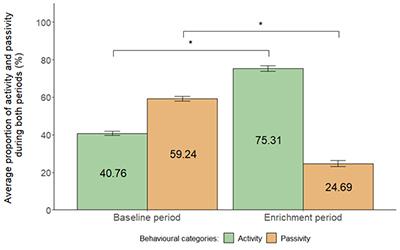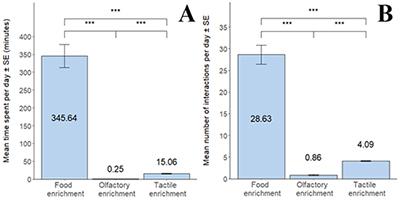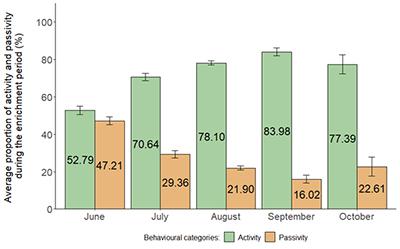Results
Baseline period vs. enrichment period

For this analysis, the four behavioural categories were merged into two new categories called “activity” and “passivity”. The “activity” category comprises of feeding behaviours, locomotory behaviours, and social interactions. The “passivity” category contains passive behaviours.
The enrichment period yielded a significantly higher proportion of the “activity” behavioural category compared to the baseline period, as well as a significantly lower proportion of the "passivity" behavioural category.
Comparison of the enrichments

For these reindeer, food enrichment was significantly more attractive than the other two enrichments presented, in regard to mean time spent with the enrichment, and the mean frequency of interactions.
The reindeer showed very little interest in olfactory enrichment, and tactile enrichment. No significant differences found in olfactory enrichment, nor in tactile enrichment, in regard to mean time spent with olfactory enrichment, and mean frequency of interactions.
Monthly comparison

When comparing the average proportion of activity and passivity of the reindeer in each month, during the enrichment period, the reindeer were significantly less active in June compared to the four other months.
They were most active in September, but it was not significant when compared to the four other months.
The reindeer spent significantly more time with food enrichment than the other two types of enrichment, in every month except for June, in regard to mean time spent interacting with the enrichment, and the mean frequency of interactions
Comparison between individual reindeer
Hallveig yielded the highest proportion of activity during both the baseline period and the enrichment period. Her activity level almost doubled, it went from about 44% to 77%However, there was not a significant difference between the reindeer.
Tindur yielded the highest proportion of activity in four out of five behavioural categories. These categories were enrichment interaction, locomotory behaviours, passive behaviours, and social interaction. Hallveig was the one to yield the highest proportion of activity in the feeding behaviours category. For this part, there was also no significant difference found between the reindeer.
Regina spent on average the most time interacting with food enrichment, while Hallveig was the one to interact on average most often with food enrichment.
In regard to olfactory enrichment, Tindur spent on average the most time with it, while Gullbrá interacted on average the most often with olfactory enrichment.
In regard to tactile enrichment, not only did Tindur spend on average the most time with this enrichment, but he was also the one to interact on average the most often with it.
However, there was not a significant difference between the reindeer.
Responsible for this page:
Director of undergraduate studies Biology
Last updated:
05/26/21
